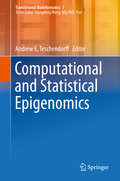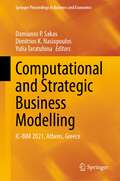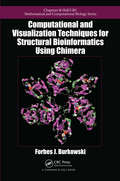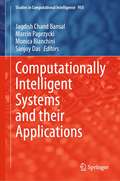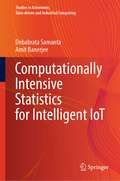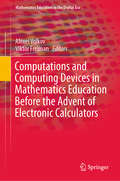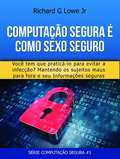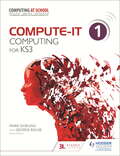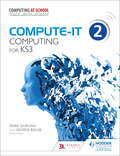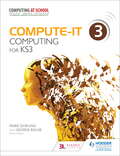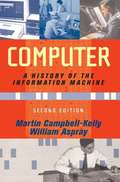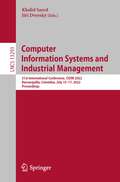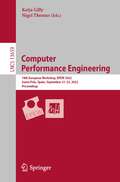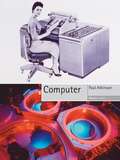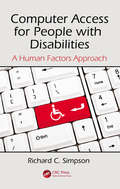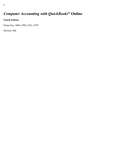- Table View
- List View
Computational and Statistical Epigenomics (Translational Bioinformatics #7)
by Andrew E. TeschendorffThis book introduces the reader to modern computational and statistical tools for translational epigenomics research. Over the last decade, epigenomics has emerged as a key area of molecular biology, epidemiology and genome medicine. Epigenomics not only offers us a deeper understanding of fundamental cellular biology, but also provides us with the basis for an improved understanding and management of complex diseases. From novel biomarkers for risk prediction, early detection, diagnosis and prognosis of common diseases, to novel therapeutic strategies, epigenomics is set to play a key role in the personalized medicine of the future. In this book we introduce the reader to some of the most important computational and statistical methods for analyzing epigenomic data, with a special focus on DNA methylation. Topics include normalization, correction for cellular heterogeneity, batch effects, clustering, supervised analysis and integrative methods for systems epigenomics. This book will be of interest to students and researchers in bioinformatics, biostatistics, biologists and clinicians alike. Dr. Andrew E. Teschendorff is Head of the Computational Systems Genomics Lab at the CAS-MPG Partner Institute for Computational Biology, Shanghai, China, as well as an Honorary Research Fellow at the UCL Cancer Institute, University College London, UK.
Computational and Strategic Business Modelling: IC-BIM 2021, Athens, Greece (Springer Proceedings in Business and Economics)
by Damianos P. Sakas Dimitrios K. Nasiopoulos Yulia TaratuhinaThis book presents advanced methods in business intelligence models that are applicable in research areas of business and enterprise research such as business informatics, e-business, customer behavior and agricultural business. Featuring selected contributions presented at the 2021 International Conference on Business Intelligence and Modelling (IC-BIM) held in Athens, Greece, this book analyses a series of issues and tools for business intelligence in everyday business operations. The International Conference on Business Intelligence and Modelling (IC-BIM) started in 2011 and is an international interdisciplinary conference focusing on the theoretical approach of the contemporary issues evolved in business intelligence and modelling and the integration of theory and practice.
Computational and Visualization Techniques for Structural Bioinformatics Using Chimera (Chapman & Hall/CRC Computational Biology Series)
by Forbes J. BurkowskiA Step-by-Step Guide to Describing Biomolecular StructureComputational and Visualization Techniques for Structural Bioinformatics Using Chimera shows how to perform computations with Python scripts in the Chimera environment. It focuses on the three core areas needed to study structural bioinformatics: biochemistry, mathematics, and computation.Und
Computationally Intelligent Systems and their Applications (Studies in Computational Intelligence #950)
by Jagdish Chand Bansal Marcin Paprzycki Monica Bianchini Sanjoy DasThis book covers all core technologies like neural networks, fuzzy systems, and evolutionary computation and their applications in the systems. Computationally intelligent system is a new concept for advanced information processing. The objective of this system is to realize a new approach for analyzing and creating flexible information processing of sensing, learning, recognizing, and action taking. Computational intelligent is a part of artificial intelligence (AI) which includes the study of versatile components to empower or encourage savvy practices in intricate and evolving situations. The computationally intelligent system highly relies on numerical information supplied by manufacturers unlike AI.
Computationally Intensive Statistics for Intelligent IoT (Studies in Autonomic, Data-driven and Industrial Computing)
by Amit Banerjee Debabrata SamantaThe book covers computational statistics, its methodologies and applications for IoT device. It includes the details in the areas of computational arithmetic and its influence on computational statistics, numerical algorithms in statistical application software, basics of computer systems, statistical techniques, linear algebra and its role in optimization techniques, evolution of optimization techniques, optimal utilization of computer resources, and statistical graphics role in data analysis. It also explores computational inferencing and computer model's role in design of experiments, Bayesian analysis, survival analysis and data mining in computational statistics.
Computations and Computing Devices in Mathematics Education Before the Advent of Electronic Calculators (Mathematics Education in the Digital Era #11)
by Viktor Freiman Alexei VolkovThis volume traces back the history of interaction between the “computational” or “algorithmic” aspects of elementary mathematics and mathematics education throughout ages. More specifically, the examples of mathematical practices analyzed by the historians of mathematics and mathematics education who authored the chapters in the present collection show that the development (and, in some cases, decline) of counting devices and related computational practices needs to be considered within a particular context to which they arguably belonged, namely, the context of mathematics instruction; in their contributions the authors also explore the role that the instruments played in formation of didactical approaches in various mathematical traditions, stretching from Ancient Mesopotamia to the 20th century Europe and North America.
Computação Segura é Como Sexo Seguro: Você tem que praticar para evitar infecções
by Richard G Lowe Jr Magno CruzProteja o Seu Computador e as Suas Informações e Fotos Importantes Sem Precisar Gastar Muito ou Contratar Um Especialista. E se alguns novos hábitos pudessem reduzir dramaticamente as chances do seu sistema ser infectado por um vírus ou atacado por um hacker? Imagine navegar na internet sem se preocupar com o terror da fraude de cartão de crédito ou roubo de identidade? E se você pudesse manter os caras maus longe com alguns simples programas. O especialista em segurança e executivo de informática, Richard Lowe, apresenta passos simples que você pode tomar para proteger o seu computador, fotos e informações de malfeitores e vírus. Usando exemplos fáceis de entender e explicações simples. Lowe explica por que hackers querem o seu computador, o que eles fazem com as suas informações e o que você pode fazer para manter eles longe. Lowe responde à pergunta: como se manter a salvo no oeste selvagem da internet. O que você vai aprender ao ler este livro? * Afinal de contas, o que os hackers tentam fazer com o seu computador e suas informações? * Como proteger o seu computador de vírus. * A melhor maneira de manter as suas contas online a salvo de hackers. * Como manter os seus dados e fotos a salvo de falhas e desastres. * Como evitar que intrusos usem a sua rede sem fio para invadir o seu computador. * Como se proteger em Wi-Fi de cafeterias. * Como usar um computador público ou de hotel de forma segura. * Como montar um firewall ao redor do seu computador para manter malfeitores longe. * Como proteger o seu computador de vírus usando um antivírus. * Como proteger a sua rede doméstica. * E muitas outras dicas e técnicas para manter os seus dados, seu crédito e a sua vida a salvo. Compre este livro AGORA, antes que seja tarde demais! Proteja o seu computador, fotos, informações e identidade. Consiga a sua cópia ho
Compute-IT 1: Computing for KS3
by Mark Dorling George RouseCompute-IT will help you deliver innovative lessons for the new Key Stage 3 Computing curriculum with confidence, using resources and meaningful assessment produced by expert educators. With Compute-IT you will be able to assess and record students' attainment and monitor progression all the way through to Key Stage 4. Developed by members of Computing at School, the national subject association for Computer Science, and a team of Master Teachers who deliver CPD through the Network of Excellence project funded by the Department for Education, Compute-IT provides a cohesive and supportive learning package structured around the key strands of Computing. Creative and flexible in its approach, Compute-IT makes Computing for Key Stage 3 easy to teach, and fun and meaningful to learn, so you can: Follow well-structured and finely paced lessons along a variety of suggested routes through Key Stage 3 Deliver engaging and interesting lessons using a range of files and tutorials provided for a range of different programming languages Ensure progression throughout Key Stage 3 with meaningful tasks underpinned by unparalleled teacher and student support Assess students' work with confidence, using ready-prepared formative and summative tasks that are mapped to meaningful learning outcomes and statements in the new Programme of Study Creative and flexible in its approach, Compute-IT makes Computing for Key Stage 3 easy to teach, and fun and meaningful to learn. This is the first title in the Compute-IT course, which comprises three Student's Books, three Teacher Packs and a range of digital teaching and learning resources delivered through Dynamic Learning.
Compute-IT: Student's Book 1 - Computing for KS3 (Compute-IT)
by Mark Dorling George Rouse Sarah Lawrey Zoe Ross Phil Bagge Graham Hastings Carl Turland Genevieve Smith-Nunes Ilia Avroutine James AbelaCompute-IT will help you deliver innovative lessons for the new Key Stage 3 Computing curriculum with confidence, using resources and meaningful assessment produced by expert educators. With Compute-IT you will be able to assess and record students' attainment and monitor progression all the way through to Key Stage 4. Developed by members of Computing at School, the national subject association for Computer Science, and a team of Master Teachers who deliver CPD through the Network of Excellence project funded by the Department for Education, Compute-IT provides a cohesive and supportive learning package structured around the key strands of Computing. Creative and flexible in its approach, Compute-IT makes Computing for Key Stage 3 easy to teach, and fun and meaningful to learn, so you can:Follow well-structured and finely paced lessons along a variety of suggested routes through Key Stage 3Deliver engaging and interesting lessons using a range of files and tutorials provided for a range of different programming languages Ensure progression throughout Key Stage 3 with meaningful tasks underpinned by unparalleled teacher and student support Assess students' work with confidence, using ready-prepared formative and summative tasks that are mapped to meaningful learning outcomes and statements in the new Programme of StudyCreative and flexible in its approach, Compute-IT makes Computing for Key Stage 3 easy to teach, and fun and meaningful to learn. This is the first title in the Compute-IT course, which comprises three Student's Books, three Teacher Packs and a range of digital teaching and learning resources delivered through Dynamic Learning.
Compute-IT: Student's Book 2 - Computing For Ks3
by Mark Dorling George RouseCompute-IT will help you deliver innovative lessons for the new Key Stage 3 Computing curriculum with confidence, using resources and meaningful assessment produced by expert educators. With Compute-IT you will be able to assess and record students' attainment and monitor progression all the way through to Key Stage 4. Developed by members of Computing at School, the national subject association for Computer Science, and a team of Master Teachers who deliver CPD through the Network of Excellence project funded by the Department for Education, Compute-IT provides a cohesive and supportive learning package structured around the key strands of Computing. Creative and flexible in its approach, Compute-IT makes Computing for Key Stage 3 easy to teach, and fun and meaningful to learn, so you can:Follow well-structured and finely paced lessons along a variety of suggested routes through Key Stage 3Deliver engaging and interesting lessons using a range of files and tutorials provided for a range of different programming languages Ensure progression throughout Key Stage 3 with meaningful tasks underpinned by unparalleled teacher and student support Assess students' work with confidence, using ready-prepared formative and summative tasks that are mapped to meaningful learning outcomes and statements in the new Programme of StudyCreative and flexible in its approach, Compute-IT makes Computing for Key Stage 3 easy to teach, and fun and meaningful to learn. This is the second title in the Compute-IT course, which comprises three Student's Books, three Teacher Packs and a range of digital teaching and learning resources delivered through Dynamic Learning.
Compute-IT: Student's Book 2 - Computing for KS3 (Compute-IT)
by Mark Dorling George RouseCompute-IT will help you deliver innovative lessons for the new Key Stage 3 Computing curriculum with confidence, using resources and meaningful assessment produced by expert educators. With Compute-IT you will be able to assess and record students' attainment and monitor progression all the way through to Key Stage 4. Developed by members of Computing at School, the national subject association for Computer Science, and a team of Master Teachers who deliver CPD through the Network of Excellence project funded by the Department for Education, Compute-IT provides a cohesive and supportive learning package structured around the key strands of Computing. Creative and flexible in its approach, Compute-IT makes Computing for Key Stage 3 easy to teach, and fun and meaningful to learn, so you can:Follow well-structured and finely paced lessons along a variety of suggested routes through Key Stage 3Deliver engaging and interesting lessons using a range of files and tutorials provided for a range of different programming languages Ensure progression throughout Key Stage 3 with meaningful tasks underpinned by unparalleled teacher and student support Assess students' work with confidence, using ready-prepared formative and summative tasks that are mapped to meaningful learning outcomes and statements in the new Programme of StudyCreative and flexible in its approach, Compute-IT makes Computing for Key Stage 3 easy to teach, and fun and meaningful to learn. This is the second title in the Compute-IT course, which comprises three Student's Books, three Teacher Packs and a range of digital teaching and learning resources delivered through Dynamic Learning.
Compute-IT: Student's Book 3 - Computing for KS3
by Mark Dorling George RouseCompute-IT will help you deliver innovative lessons for the new Key Stage 3 Computing curriculum with confidence, using resources and meaningful assessment produced by expert educators. With Compute-IT you will be able to assess and record students' attainment and monitor progression all the way through to Key Stage 4. Developed by members of Computing at School, the national subject association for Computer Science, and a team of Master Teachers who deliver CPD through the Network of Excellence project funded by the Department for Education, Compute-IT provides a cohesive and supportive learning package structured around the key strands of Computing. Creative and flexible in its approach, Compute-IT makes Computing for Key Stage 3 easy to teach, and fun and meaningful to learn, so you can:Follow well-structured and finely paced lessons along a variety of suggested routes through Key Stage 3Deliver engaging and interesting lessons using a range of files and tutorials provided for a range of different programming languages Ensure progression throughout Key Stage 3 with meaningful tasks underpinned by unparalleled teacher and student support Assess students' work with confidence, using ready-prepared formative and summative tasks that are mapped to meaningful learning outcomes and statements in the new Programme of StudyCreative and flexible in its approach, Compute-IT makes Computing for Key Stage 3 easy to teach, and fun and meaningful to learn. This is the third title in the Compute-IT course, which comprises three Student's Books, three Teacher Packs and a range of digital teaching and learning resources delivered through Dynamic Learning.
Compute-IT: Student's Book 3 - Computing for KS3 (Compute-IT)
by Mark Dorling George RouseExam Board: OCR, AQA, Edexcel & WJECLevel: KS3Subject: MathematicsFirst Teaching: September 2015First Exam: June 2016Compute-IT will help you deliver innovative lessons for the new Key Stage 3 Computing curriculum with confidence, using resources and meaningful assessment produced by expert educators. With Compute-IT you will be able to assess and record students' attainment and monitor progression all the way through to Key Stage 4. Developed by members of Computing at School, the national subject association for Computer Science, and a team of Master Teachers who deliver CPD through the Network of Excellence project funded by the Department for Education, Compute-IT provides a cohesive and supportive learning package structured around the key strands of Computing. Creative and flexible in its approach, Compute-IT makes Computing for Key Stage 3 easy to teach, and fun and meaningful to learn, so you can:Follow well-structured and finely paced lessons along a variety of suggested routes through Key Stage 3Deliver engaging and interesting lessons using a range of files and tutorials provided for a range of different programming languages Ensure progression throughout Key Stage 3 with meaningful tasks underpinned by unparalleled teacher and student support Assess students' work with confidence, using ready-prepared formative and summative tasks that are mapped to meaningful learning outcomes and statements in the new Programme of StudyCreative and flexible in its approach, Compute-IT makes Computing for Key Stage 3 easy to teach, and fun and meaningful to learn. This is the third title in the Compute-IT course, which comprises three Student's Books, three Teacher Packs and a range of digital teaching and learning resources delivered through Dynamic Learning.
Computer
by Martin Campbell-Kelly William Aspray Nathan Ensmenger Jeffrey R. YostComputer: A History of the Information Machine traces the history of the computer and shows how business and government were the first to explore its unlimited, information-processing potential. Old-fashioned entrepreneurship combined with scientific know-how inspired now famous computer engineers to create the technology that became IBM. Wartime needs drove the giant ENIAC, the first fully electronic computer. Later, the PC enabled modes of computing that liberated people from room-sized, mainframe computers. This third edition provides updated analysis on software and computer networking, including new material on the programming profession, social networking, and mobile computing. It expands its focus on the IT industry with fresh discussion on the rise of Google and Facebook as well as how powerful applications are changing the way we work, consume, learn, and socialize. Computer is an insightful look at the pace of technological advancement and the seamless way computers are integrated into the modern world. Through comprehensive history and accessible writing, Computer is perfect for courses on computer history, technology history, and information and society, as well as a range of courses in the fields of computer science, communications, sociology, and management.
Computer
by Martin Campbell-Kelly William Aspray Nathan Ensmenger Jeffrey R. YostComputer: A History of the Information Machine traces the history of the computer and shows how business and government were the first to explore its unlimited, information-processing potential. Old-fashioned entrepreneurship combined with scientific know-how inspired now famous computer engineers to create the technology that became IBM. Wartime needs drove the giant ENIAC, the first fully electronic computer. Later, the PC enabled modes of computing that liberated people from room-sized, mainframe computers.This third edition provides updated analysis on software and computer networking, including new material on the programming profession, social networking, and mobile computing. It expands its focus on the IT industry with fresh discussion on the rise of Google and Facebook as well as how powerful applications are changing the way we work, consume, learn, and socialize. Computer is an insightful look at the pace of technological advancement and the seamless way computers are integrated into the modern world. Through comprehensive history and accessible writing, Computer is perfect for courses on computer history, technology history, and information and society, as well as a range of courses in the fields of computer science, communications, sociology, and management.
Computer
by Martin Campbell-Kelly William AsprayCampbell-Kelly (University of Warwick) and Aspray (Indiana University) describe the way computing was handled before the arrival of electronic computers, and recount the development of the mainframe computer. They review the origins of office machinery, early failed attempts to build a calculating engine, scientific war programs, the IBM system/360 family of computers, and the importance of real time for common commercial applications. The second edition expands the later sections on CD-ROMs, the internet, and web commerce. Annotation ©2004 Book News, Inc. , Portland, OR (booknews. com)
Computer
by Martin Campbell-Kelly William AsprayComputer: A History of the Information Machine, Second Edition traces the story of the computer, and shows how business and government were the first to explore its unlimited, information-processing potential. Old-fashioned entrepreneurship combined with scientific know-how inspired now famous computer engineers to create the technology that became IBM. Wartime needs drove the giant ENIAC, the first fully electronic computer. Later, the PC enabled modes of computing that liberated people from room-sized, mainframe computers. This second edition now extends beyond the development of Microsoft Windows and the Internet, to include open source operating systems like Linux, and the rise again and fall and potential rise of the dot.com industries.
Computer
by Martin Campbell-Kelly William Aspray"Computer: A History of the Information Machine, Second Edition traces the story of the computer, and shows how business and government were the first to explore its unlimited, information-processing"
Computer Information Systems and Industrial Management: 21st International Conference, CISIM 2022, Barranquilla, Colombia, July 15–17, 2022, Proceedings (Lecture Notes in Computer Science #13293)
by Khalid Saeed Jiří DvorskýThis book constitutes the proceedings of the 21st International Conference on Computer Information Systems and Industrial Management Applications, CISIM 2022, held in Barranquilla, Colombia, in July 2022. The 28 papers presented together with 3 keynotes were carefully reviewed and selected from 68 submissions. The main topics covered by the chapters in this book are biometrics, security systems, multimedia, classification and clustering, and industrial management as well as interesting papers on computer information systems as applied to wireless networks, computer graphics, and intelligent systems.
Computer Performance Engineering: 18th European Workshop, EPEW 2022, Santa Pola, Spain, September 21–23, 2022, Proceedings (Lecture Notes in Computer Science #13659)
by Nigel Thomas Katja GillyThis book constitutes the refereed proceedings of the 18th European Workshop on Computer Performance Engineering, EPEW 2022, held in Santa Pola, Spain, in September 2022.The 14 papers presented in this volume together with one invited talk were carefully reviewed and selected from 14 submissions. The papers presented at the workshop reflect the diversity of modern performance engineering. The sessions covered a wide range of topics including robustness analysis, machine learning, edge and cloud computing, as well as more traditional topics on stochastic modelling, techniques and tools.
Computer (Objekt Series)
by Paul AtkinsonThe history of the computer as it decreased in size and increase in functionality and popularity. This book covers the change in its design, how promoted through advertising, and represented in our culture.
Computer Access for People with Disabilities: A Human Factors Approach (Rehabilitation Science in Practice Series)
by Richard C. SimpsonIncorporating Compass Computer Access Assessment software, Computer Access for People with Disabilities: A Human Factors Approach provides the information clinicians need to know in order to provide effective alternative computer access solutions to individuals with disabilities. This book presents technology for individuals with physical, cognitive, and sensory impairments, and for older adults. The text covers text entry devices, pointing devices, switch access, automatic speech recognition, and web accessibility. The book draws on research from the fields of rehabilitation engineering, occupational therapy, and human-computer interaction (HCI) and emphasizes fundamental concepts and principles that remain true regardless of which specific operating system or product is being used.
Computer Accounting with QuickBooks Online
by Donna KayGain a competitive advantage – learn a leading online financial app for entrepreneurs with Computer Accounting with QuickBooks Online. Designed using the most effective way to learn QuickBooks Online, this text streamlines learning QuickBooks Online because it focuses on you―the learner. Proven instructional techniques are incorporated throughout the text to make your mastery of QuickBooks Online as effortless as possible. Using a hands-on approach, this text integrates understanding accounting with mastery of QuickBooks Online. Designed for maximum flexibility to meet your needs, Computer Accounting with QuickBooks Online can be used either in a QuickBooks Online course or independently at your own pace.
Computer Adhyan class 10 - GSTB: કમ્પ્યુટર અધ્યયન ધોરણ ૧૦
by Gujrat Rajya Pathyapustak Mandalધોરણ ૧૦ ની કમ્પ્યુટર અધ્યન નું પાઠ્યપુસ્તક છે જેમાં 13 પ્રકરણ આપેલ છે.
Computer Adhyan class 11 - GSTB: કમ્પ્યૂટર અધ્યયન ધોરણ 11
by Gujrat Rajya Pathyapustak Mandalધોરણ ૧૧ ની કમ્પ્યુટર અધ્યન નું પાઠ્યપુસ્તક છે જેમાં 13 પ્રકરણ આપેલ છે.
